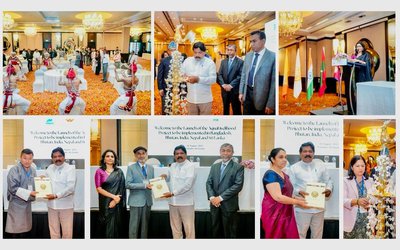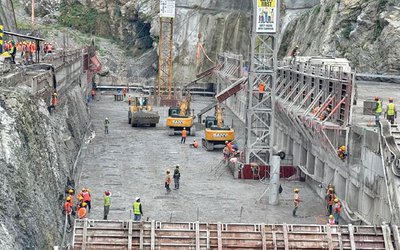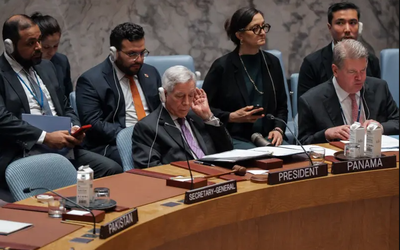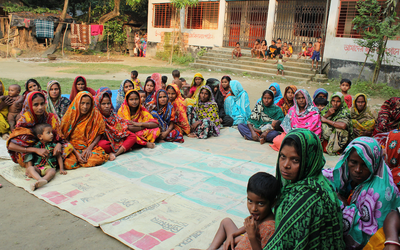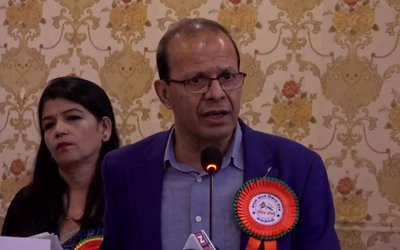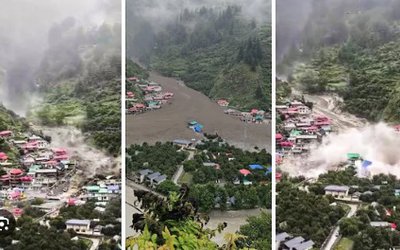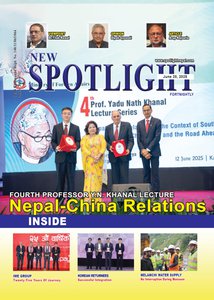The Attack That Shocked Kashmir—and Exposed a Geopolitical Script
On April 22, 2025, gunmen stormed a meadow in Pahalgam, Kashmir, slaughtering 26 civilians—predominantly Hindu tourists—in the deadliest attack on civilians in the region since 2008. The Indian government swiftly blamed Pakistan-based militants, suspended diplomatic ties, and halted the Indus Waters Treaty, escalating tensions in a nuclear-armed neighbourhood already reeling from decades of mistrust. Yet as grief turns to anger, a critical question pierces the fog of blame: Who truly benefits from this carnage?
The answer lies not in Srinagar or Islamabad but in Washington’s century-old playbook of divide-and-rule—a strategy now amplified by the U.S.’s desperation to retain dominance in a multipolar world.
The Grand Chessboard Revisited: America’s Obsession with Eurasian Fragmentation
Zbigniew Brzezinski’s The Grand Chessboard (1997) framed Eurasia as the “geo-strategic pivot” of global power, urging the U.S. to prevent rivals like China or Russia from consolidating influence. Kashmir, bordering China, Pakistan, and Afghanistan, sits at the heart of this vision. Its instability serves Washington’s interests by disrupting trade corridors critical to Beijing’s Belt and Road Initiative (BRI) and India’s connectivity to Central Asia.
Brzezinski’s logic is chillingly clear: a united South Asia threatens U.S. hegemony. A stable India-Pakistan détente or a robust China-India partnership could create an economic bloc immune to Western financial systems. Conversely, conflict keeps the region dependent on American security guarantees and dollar-denominated trade. This explains why U.S. Vice President JD Vance’s visit to India coincided with the Pahalgam attack—a timing that amplified global scrutiny on India-Pakistan tensions and derailed India’s growing ties with Iran, a corridor bypassing U.S.-controlled sea lanes.
Historical Echoes: From Truman to Trump, a Legacy of Weaponised Chaos
The U.S. has long treated South Asia as a theatre for proxy warfare. During the Cold War, Pakistan became a frontline state against Soviet expansion, receiving billions in military aid despite its authoritarian regimes. Post-9/11, the “War on Terror” turned Afghanistan and Pakistan into battlegrounds, destabilising the region while justifying perpetual U.S. military presence.
Kashmir’s turmoil fits this pattern. The 2000 Chittisinghpora massacre, which killed 36 Sikhs, coincided with Bill Clinton’s visit to India, forcing New Delhi to seek U.S. mediation. Today, the Pahalgam attack mirrors this script, exploiting regional fractures to justify increased arms sales and intelligence partnerships. As economist Jeffrey Sachs warned in April 2025, Washington’s “new Cold War” against China relies on fracturing the Global South: “The U.S. wants to use India against China... but India is a civilisation, not a pawn”.
Cui Bono? The Hidden Architect of Kashmir’s Suffering
Let us dissect the beneficiaries of this bloodshed. Kashmiri Muslims face brutal crackdowns and economic isolation, with the attack sparking reprisals against students in India. India’s “Naya Kashmir” tourism narrative lies in tatters, undermining claims of normalised security post-2019 autonomy revocation. Pakistan, accused of harbouring militants, faces diplomatic isolation and the suspension of the Indus Waters Treaty—a move threatening its agriculture-dependent economy. China, too, suffers: violence disrupts the China-Pakistan Economic Corridor (CPEC), a $62 billion BRI flagship project.
Only one actor benefits: the United States. By stoking India-Pakistan hostility, the U.S. weakens China’s regional partnerships, isolates Russia, and justifies military sales to “contain” Beijing. This aligns with John Mearsheimer’s The Tragedy of Great Power Politics (2001), which posits that in an anarchic world, powers relentlessly sabotage rivals to maintain hegemony.
The Shanghai Cooperation Organization: A Path Out of the Quagmire
Here lies the paradox: India and Pakistan, though locked in a “no peace-no war” stalemate, are both members of the Shanghai Cooperation Organization (SCO)—a multilateral body designed to counteract terrorism and foster Eurasian stability. The SCO’s Regional Anti-Terrorist Structure (RATS) has already proven effective, preventing 20 attacks and neutralising 1,700 terrorists between 2011-2015. Yet its potential remains untapped in Kashmir.
Three steps could transform the SCO into a peacemaker:
- Mediation Mechanism: The SCO should leverage its 2025 Astana Summit commitments to establish a Kashmir working group, inviting neutral members like Kazakhstan and Uzbekistan to facilitate dialogue. This would sideline Western interference, echoing the SCO’s founding principle of “non-alignment”.
- Counterterrorism Collaboration: Joint intelligence-sharing through RATS could expose external actors funding militancy. For instance, the SCO’s 2017 Convention on Countering Extremism mandates member states to block financing networks—a tool that could dismantle proxies exploiting Kashmiri grievances.
- Economic Confidence-Building: The SCO’s $1.3 trillion combined GDP offers leverage. By linking India’s digital infrastructure with Pakistan’s agriculture via SCO-backed trade corridors, the bloc could create interdependencies that reduce hostility.
As Jeffrey Sachs argues, India must resist becoming a “military pawn” in U.S. containment strategies and instead embrace SCO-led multipolarity: “A stable Eurasia needs India and China to co-exist, not collide”.
The Ghost of Mackinder: Why Kashmir’s Stability Matters Globally
In 1904, Sir Halford Mackinder warned that whoever controls Eurasia’s “Heartland” commands the world. Kashmir, linking South and Central Asia, is the linchpin of this Heartland. Its instability disrupts China’s energy routes, India’s Afghan connectivity, and Russia’s southern flank—a trifecta of chaos that perpetuates reliance on U.S. naval dominance.
The U.S. understands this intimately. By keeping Kashmir volatile, it ensures no regional power consolidates control over trade routes. The result? A fractured Eurasia, perpetually dependent on Washington’s security umbrella.
Toward a Post-Imperial South Asia: Rejecting Subjugation
South Asia need not resign itself to this fate. The region’s history—from Ashoka’s Dharma to Gandhi’s nonviolence—teaches that unity is resistance. To break free, three shifts are urgent:
- Economic Decolonisation: India’s rupee trade agreements with the UAE and Russia offer a blueprint for de-dollarisation. Expanding these to Pakistan via SCO platforms could weaken U.S. financial coercion.
- Grassroots Solidarity: Initiatives like the Southasia Peace Action Network (Sapan) prove that people-to-people ties can transcend state hostilities. SCO cultural exchanges could amplify this, fostering joint climate or tech projects.
- Neutrality as Defiance: India’s Cold War-era non-alignment, though imperfect, offers lessons. By refusing to serve as a U.S. or Chinese proxy, South Asia could reclaim agency—a stance Sachs endorses: “Don’t let the U.S. say, ‘You’re with us or against them’”.
Rewriting the Script
The Pahalgam attack is a grim reminder: empires thrive on division. South Asia holds the pen to rewrite its destiny. As Pakistani poet Faiz Ahmed Faiz implored: “Bol, ke lab āzād haiñ tere…” (Speak, for your lips are free). Let the region speak—not in the language of terror, but through the SCO’s mediating voice, economic bridges, and shared rejection of external manipulation.
The alternative? Eternal subjugation to a distant power that profits from our blood—and the tragic farce of brother killing brother on a chessboard not their own.
*Zakir Kibria is a writer and nicotine fugitive. Entrepreneur | Policy Analyst |
Chronicler of Entropy | Cognitive Dissident. “Empires decay. Pragmatism
survives. Stay sarcastic.” Email: zk@krishikaaj.com
Citations:
- Geopolitical significance of Kashmir; U.S. historical interventions
- SCO’s counterterrorism mechanisms and economic role
- Jeffrey Sachs’ warnings on U.S. strategy
- Indus Waters Treaty and BRI disruptions
- The Tehran Gambit: How America’s War on Iran Accelerated the Birth of a Post-Western World
- Aug 05, 2025
- The Digital Strip Search: How America’s Social Media Visa Edicts Redraw Colonial Borders in Cyberspace
- Jul 14, 2025
- The Iron Silk Road: How a Train to Tehran is Rewriting The World’s Map – And Why The Old Powers Are Terrified
- Jun 25, 2025
- The Kuala Lumpur Pivot: How A Silent Summit In Malaysia Is Rewriting The Global Economic Map
- Jun 16, 2025
- The Rise of Mediation Diplomacy – How Hong Kong’s IOMed Charts a New Path for a Multipolar World
- May 28, 2025






